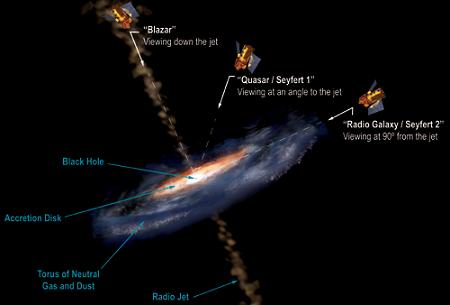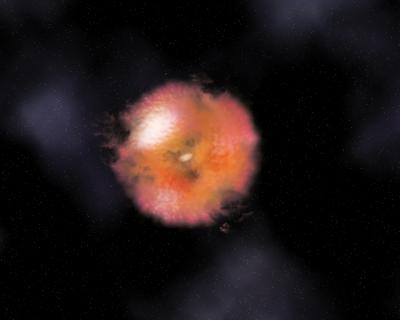Super-Massive Black Hole Powers Gas-Shrouded Active Galaxy
You’d think that astronomers would have found all the different
classes of active galaxy nuclieu (AGN ) - after all, AGN such as
quasars, blazars, and Seyfert galaxies are among the most
luminous objects in our Universe, pouring out the energy of
billions of stars from a region no larger than our solar system.
But a team has discovered that a relatively common class of AGN
has escaped detection until now. These objects are so heavily
shrouded in gas and dust that virtually no light gets out.
"This is an important discovery because it will help us better
understand why some supermassive black holes shine and others
don’t," says astronomer and team member Jack Tueller of NASA’s
Goddard Space Flight Center in Greenbelt, Md.

This illustration shows the different features of an active
galactic nucleus (AGN), and how our viewing angle determines
what type of AGN we observe. The extreme luminosity of an AGN is
powered by a supermassive black hole at the center. Some AGN
have jets, while others do not. Click on image for unlabeled,
high-res version. Image credit: Aurore Simonnet, Sonoma State
University.
Using Swift’s Burst Alert Telescope (BAT), a team led by Tueller
has found several hundred relatively nearby AGNs that were
previously missed because their visible and ultraviolet light
was smothered by gas and dust. The BAT was able to detect
high-energy X-rays from these heavily blanketed AGNs because,
unlike visible light, high-energy X-rays can punch through thick
gas and dust.
To follow up on this discovery, Yoshihiro Ueda of Kyoto
University, Japan, Tueller, and a team of Japanese and American
astronomers targeted two of these AGNs with Suzaku. They were
hoping to determine whether these heavily obscured AGNs are
basically the same type of objects as other AGN, or whether they
are fundamentally different. The AGNs reside in the galaxies ESO
005-G004 and ESO 297-G018, which are about 80 million and 350
million light-years from Earth, respectively.
Suzaku covers a broader range of X-ray energies than BAT, so
astronomers expected Suzaku to see X-rays across a wide swath of
the X-ray spectum. But despite Suzaku’s high sensitivity, it
detected very few low- or medium-energy X-rays from these two
AGN, which explains why previous X-ray AGN surveys missed them.
According to popular models, AGNs are surrounded by a
donut-shaped ring of material, which partially obscures our view
of the black hole. Our viewing angle with respect to the donut
determines what type of object we see. But team member Richard
Mushotzky, also at NASA Goddard, thinks these newly discovered
AGN are completely surrounded by a shell of obscuring material.
"We can see visible light from other types of AGN because there
is scattered light," says Mushotzky. "But in these two galaxies,
all the light coming from the nucleus is totally blocked."
Another possibility is that these AGN have little gas in their
vicinity. In other AGN, the gas scatters light at other
wavelengths, which makes the AGN visible even if they are
shrouded in obscuring material.
"Our results imply that there must be a large number of yet
unrecognized obscured AGNs in the local universe," says Ueda.

In the newly discovered type of AGN, the disk and torus
surrounding the black hole are so deeply obscured by gas and
dust that no visible light escapes, making them very difficult
to detect. This illustration shows the scene from a more distant
perspective than does the other image. Credit: Aurore Simonnet,
Sonoma State University.
In fact, these objects might comprise about 20 percent of point
sources comprising the X-ray background, a glow of X-ray
radiation that pervades our Universe. NASA’s Chandra X-ray
Observatory has found that this background is actually produced
by huge numbers of AGNs, but Chandra was unable to identify the
nature of all the sources.
By missing this new class, previous AGN surveys were heavily
biased, and thus gave an incomplete picture of how supermassive
black holes and their host galaxies have evolved over cosmic
history. "We think these black holes have played a crucial role
in controlling the formation of galaxies, and they control the
flow of matter into clusters," says Tueller. "You can’t
understand the universe without understanding giant black holes
and what they’re doing. To complete our understanding we must
have an unbiased sample."
